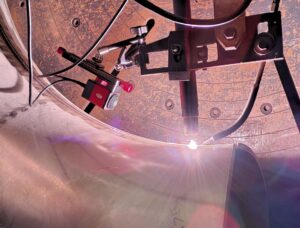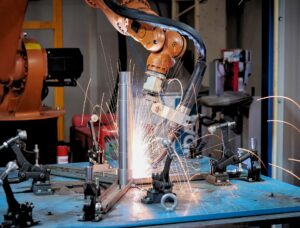Why proper filtering is key to clear, accurate weld monitoring
In this blog, we’ll explore the importance of arc filtering in welding cameras and why proper filtering technology is essential for clear, accurate weld monitoring in bright arc environments. Welding cameras have revolutionized how professionals observe and document welding processes—offering real-time insights, quality control, and increased safety. But one critical feature makes these tools truly functional: arc filtering. Without effective arc filtering, the intense brightness of the welding arc can overwhelm the camera sensor, obscure the weld pool, and render footage unusable. In this post, we’ll break down why arc filtering is essential, how it works, and what to look for when choosing a camera system.
What Is Arc Filtering?
Arc filtering refers to the camera’s ability to manage the extreme brightness and light variability of the welding arc. During welding, especially in processes like MIG, TIG, and SMAW, the arc emits:
- Intense white light
- Infrared (IR) radiation
- Ultraviolet (UV) radiation
Without the right filters, this brightness saturates the camera, causing glare, overexposure, and a complete loss of visibility in the weld zone.
Why Arc Filtering Matters
See the Weld Pool Clearly
Proper filtering lets operators monitor the molten weld pool in real time—crucial for ensuring full penetration, proper fusion, and bead shape.
Reduce Eye Strain for Operators
Filtered footage can be viewed safely by human operators, without harsh flickering or excessive glare on screens.
Enable Automated Monitoring
For robotics and AI-based systems, clean and accurate visual input is critical for automated decision-making and weld defect detection.
Capture Usable Footage
High-speed, filtered images provide valuable documentation for inspection, training, and compliance purposes.
Types of Arc Filtering Technologies
- Optical Filters
Physical filters (like ND or IR-blocking filters) placed in front of the lens to reduce light intensity. - Digital HDR Processing
High Dynamic Range imaging that captures multiple exposure levels and blends them to retain detail in both bright and dark areas. - Auto-Dimming Systems
Advanced cameras adjust exposure dynamically in response to arc intensity changes—similar to auto-darkening welding helmets. - Specialized Arc Imaging Sensors
Some cameras use sensors designed to specifically handle the light spectrum of welding arcs.
What Happens Without Arc Filtering?
- Washed-out images with no visible weld pool
- Flashes of light that trigger false alerts in automated systems
- Inability to capture defects or misalignments
- Increased risk of bad welds going unnoticed
- Damaged sensors due to prolonged overexposure
Choosing a Welding Camera with Proper Arc Filtering
When evaluating a welding camera for industrial use, look for:
- High-performance optical and digital filters
- Proven performance in high-arc brightness environments
- Adjustable exposure settings
- Ability to view both arc and base material simultaneously
- Compatibility with your specific welding process (MIG, TIG, SAW, etc.)
Real-World Applications
- Automotive manufacturing: Monitoring fast-moving MIG welds with consistent clarity
- Shipbuilding: Ensuring deep penetration welds on thick materials
- Pipeline construction: Remote monitoring of high-heat welds in real time
- Nuclear sector: Verifying critical welds under extreme conditions
In each of these industries, arc filtering ensures the camera sees what matters: the weld itself.
Final Thoughts: The Importance of Arc Filtering in Welding Cameras
Arc filtering isn’t a “nice-to-have” feature—it’s the foundation of any effective welding camera system. Without it, even the most advanced camera hardware can’t deliver the clarity and detail needed to monitor and inspect welds effectively.
Whether you’re working on a small fabrication bench or managing automated systems in high-risk environments, choosing a camera with robust arc filtering is essential for safety, quality, and performance.
Need help finding the right welding camera with advanced arc filtering?
At Mecaweld, we provide systems designed to handle the demands of arc-intensive processes across industries. Reach out today to explore options tailored to your welding needs.



